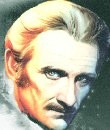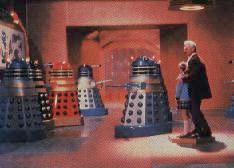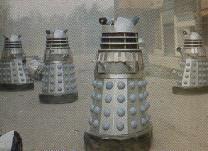 |
The Dalek Movies |
 |
The Dalek Movies |
|
|
|

|
Peter Cushing (Dr Who), Roy Castle (Ian), Jennie
Linden (Barbara), Roberta Tovey (Susan), Barrie Ingham (Alydon),
Michael Coles (Ganatus), Yvonne Antrobus (Dyoni), Geoffrey
Toone (Temmosus), John Bown (Antodus), Mark Petersen (Elyon);
Ken Garady, Nicholas Head, Michael Lennox, Jack Waters, Virginia Tyler,
Jane Lumb, Bruce Wells, Martin Grace, Sharon Young, Gary Wyler (Thals)*;Bruno
Castagnoli, Micahel Dillon, Brian Hands, Robert Jewel, Kevin Manser, Eric
McKay, Len Saunders, Gerald Tayler (Dalek Operators); Peter Hawkins,
David Hawkins (Dalek Voice)*.
* Uncredited
|
The overall plot is similar to the Doctor Who serial The Daleks. Both productions tell the story of a party of four travellers in space and time arriving on the planet Skaro - once devastated by a nuclear war - and being captured by the mutated Daleks in their metal city. As on television, the travellers subsequently ally themselves withthe other intelligenty race on Skaro, the Thals, and motivate them into defending themselves against the Daleks. The leads, too have their similarities to their television counterparts, most immediately their names. Just as William Hartnell was credited throughout his tenure as playing a character called 'Doctor Who', so too does Peter Cushing (although on film his character is explicitely referred as such). Unlike Hartnell's Doctor, Doctor Who is a human being, resident in an ordinary house in England. As on television, he is close to his granddaughter, Susan, although she here appears to be at least five years younger, and while she exhibits a precosious intellect, is a much more identifiable youngster. Jennie Linden's Barbara is the same age as the televison character, although rather than being Susan's history teacher, she is also a granddaughter of Doctor Who. It is never stated wheter she and Susan are sisters, but they share the same interest in popular science. Neither Susan or Barbara are given surnames, but it is har to imagine they are called 'Who' as well. Ian Chesterton is Barbara's boyfriend, and at the film's beginning has already met Susan but never Doctor Who, or encountered their invention. This is TARDIS (not the TARDIS; it is never prefaced with the definite article). Outwardly ressembling a police telephone box, for no stated reason, it internally contains a single much larger room. Entry is via the police box's doors, which open outwards, and still look like police box doors inside the ship. The acronym TARDIS, as in the first telivision serial, stands for Time And Relative Dimension In Space. Doctor Who is sure that he is completely able to control TARDIS' movements through time and space, although, as the film begins, the machine has just been completed; this is its maiden voyage. On television, the operation of the TARDIS was vague, but here, TARDIS is described by Doctor Who as able to break itself and its occupants down into their constituen electrical charges and sent them to their destination, where they are reassembled. Travel is virtually instantaneous. The functions of the leads within the film are subtly different from those of its small-screen progenitor. Doctor Who is a far more benevolent figure, in whom the viewer can trust, so there is less for Ian Chesterton to be a stout, dependable brother with whom the audience can identify. Consequently, Roy Castle's Ian is far wetter behind the ears than William Russell's. It's a more humorous characterisation and uses Castle's comic physical skills to great effect for the first half, such as in the completely new slapstick scene where he has to sit on a sensor to operate the door to the Dalek city. Later on, when things get tougher, Ian needs to be more of a hero, and reverts back to his television persona, most notably in contrast to Antodus (here, the Thal loses his nerve at the chasm). There is less dissent amongst the travellers than on television. Hartnell's Doctor concocts the substerfuge of refilling the TARDIS' fluid link with mercury to trick his companions into visiting the city. Cushing's Who, on the other hand, is being entirely honest. And, it must be said, he is far more the stereotypical absent-minded professor; later, he simply forgets that the link is empty when attempting to leave Skaro. Cushing's Doctor Who is not as ruthless; he doesn't suggest abandoning the Thals to their fate when he knows they have been lured into the Dalek city by the promise of food to be ambushed. Oddly, given his more passive nature, it is he, rather than Ian, who stirs the Thals into action by pretending to suggest offering their princess, Dyoni, to the Daleks for experimentation. The film's storyline is an improvement on the teleplay; its enforced abridgement to half its original running time grants it a simpler dramatic urgency. For instance, on television, the Daleks - realising that the Thal's anti-radiation drugs have a detrimental effects upon themselves - experiment only to discover they have mutated. Now knowing themselves to be dependent upon radiation, they initially decide to explode another neutron bomb, thereby making Skaro more habitable for themselves. On finding that it is not immediately possible, they decide instead to flood the planet with radiation from their nuclear reactor, destroying the Thals in the process. In the film, however, the Daleks discovering that the drugs do not work for them, simply decide to explode a bomb immediately. Less subtle, but far more exciting. The fasten-paced film version manages to retain the story dramatic high points such as Barbara and the viewers' first encounter with a Dalek, and the first sight of the Dalek control room. Obviously, the feature version loses the serial's memorable cliffhangers, including early Doctor Who's most litera example for sucha moment, where Ian hangs on to a ledge for dear life. But teh Sixties convention of Doctor Who stories leading into one another is maintained; TARDIS lands amongst stock footage of an advancing Roman Legion, and Ian appears to finally lose his sanity. What an adventure that would have made! Source: From small screen to big screen by Dave Owen, from Doctor Who Magazine Spring Special (1996), pp.22-23. See also Doctor Who Magazine Archive: Issue #353. |
|
|
|
|

|
Peter Cushing (Dr Who), Bernard Cribbins (Tom
Campbell), Ray Brooks (David), Andrew Keir (Wylen), Roberta
Tovey (Susan), Jill Curzon (Louise), Roger Avon (Wells),
Geoffrey Cheschire (Roboman), Keith Marsh (Conway), Philip
Madoc (Brockley), Steve Peters (Leader Roboman), Eddie Powell
(Thompson), Godfrey Quigley (Dortmun), Peter Reynolds (Man
on Bicyle), Bernard Spear (Man with Carrier bag), Sheila Steafel
(Young Woman), Eileen Way (Old Woman), Keneth Watson (Craddock),
John Wreford (Robber), Robert Jewell (Leader Dalek Operator).
|
Rather than relying upon regular viewers' foreknowledge of the format, as Terry Nation's second Dalek television serial The Dalek Invasion of Earth was able to, the second Doctor Who feature had to re-establish the premise of the eccentric inventor and his remarkable machine; it is as well, then, that there are new romantic leads joining Doctor Who and Susan for their adventures in the wasted future of Earth. Louise, like Barbara in the first film, is a relative of Doctor Who, this time his niece; she, too, is already familiar with the capabilities of TARDIS at the outset. However, like Ian before him, Special Constable Tom Campbell is a newcomer, mistaking TARDIS for a real Police Box while attempting to foil a jewel robbery; it is through this character that the viewer encounters the time travellers. Rather than attempting to return his companions to contemporary London, Doctor Who is deliberately setting out an expedition to the city in the year 2150. As well as different opening, a different climax is necessary, since Roberta Tovey's Susan was obviously too young to be married off to freedom fighter David Campbell. David loses not only his love interest but his surname in the move to the big screen, donating the latter to Tom. Other minor character changes include resistance man Tyler becoming Wyler, and privateer Ashton becoming Brockley. The character of Jenny disappears completely. The film's storyline is broadly similar to its television progenitor. TARDIS is trapped by a falling girder, the Doctor and Ian/Tom are captured by the Daleks and their brainwashed human servants, the Robomen, and taken to their saucer. Meanwhile, Susan and Barbara/Louise fall in with the resistance. Discovering more about the Daleks' invasion, the various parties independently make their way north to the Daleks' mine in Bedfordshire where they thwart the invaders' plans to remove the Earth's core. However, there are many many more subtle differences here than in the first film. On television, it is Ian and fellow prisoner Larry who are taken north by the Dalek saucer; here it is Tom and Louise. Unlike Roy Castle's Ian, Tom only has one blatantly comic sequence, where he attempts to pass muster as a Roboman by joining them in a regimented meal break. Rather than Jenny and Barbara travelling in a disused van, it is Wyler and Susan. On television, the van is liberated from a transport museum, reminding viewers that the story is set in the twenty-second century. No such technique is employed in the film - and with the humans' Fifties clothing, one soon forgets that it is set in the future at all. Travelling on foot on television were the Doctor, Susan, David and Tyler, but here it is just Doctor Who and David. They go overland rather than sticking to the sewers, thereby avoiding the escaped zoo alligators of the serial; the Daleks's mine workings are also predominantly shown from above ground. Completely absent from the film is the Daleks's pet monster, the Slyther; it's quite unnecessary, for the atmosphere of dread in the mine area is portrayed well - especially when the loathsome Brockley is exterminated by the Daleks after betraying the Doctor. Compared to The Dalek Invasion of Earth, Daleks' Invasion Earth 2150 A.D, is more of a sequence of elaborately-staged action set-pieces. The teleplay's visual shocks - such as the effective yet perplexing emergence of the first Dalek from the Thames, and the destruction of the van from the Dalek saucer - have been retained, but at the expense of much character development and identififcation. Obviously, Susan and David's romance is missing; regrettably, Nation's touching metaphor for humanity's fate - the scene where Larry Madison, seraching for his lost brother in the mine, discovers his sibling to have been Robotised and his forced to kill him - is replaced with the simple recognition that one of the Robomen in the mine is Craddock, whom we had earlier seen captured with Doctor Who and Tom. With its higher budget, the second film swarfs Dr. Who and the Daleks visually but, because of its quasi-contemporary setting, has dated more than the first film's depiction of a totally alien world. If the first film's plot was inspired by Nazi racial purity, then this representation of a shaterred London is surely a science fiction version of the Blitz. The visual highpoint is the Dalek saucer, with its counter-rotating decks and elegant observation gallery; the television "plate on a shoe-string"simply does not bear comparison. The film's Robomen with their shiny PVC jumpsuits, mirrored sunglasses and crash-helmet are an impressive enough phalanx of stormtroopers, but lack the horrific pathos of the BBC's ragged zombies, with their more surgically functional control helmets. Peter Cushing is less to the fore than in his Doctor Who debut, although his habit of keeping well out of trouble whenever possible remains, as does is engaging mannerism of deliberately putting on his gloves whenever about to venture forth, like a rose gardener about to tackle a particularly virulent strain of greenfly. He's joined by a strong cast, including Andrew Keir as the gruff Wyler, and a superb Philip Madoc as the repugnant Brockley, replete with spiv's cigarette and fresh Gannex mac. The differences between the teleplay and screenplay are typified by their respective climaxes. The former is a deeply emotional surprise; the Doctor deliberately strands Susan on earth to forge a new life with David. The film, however, simply ends with an appropriately cinematic bangs as the Dalek saucer, gyros groaning, crashes back to Earth. There's a charming tail-piece where Tom's new friends deposit him back in london a few minutes before the robbery, giving him the benefit of hindsight to catch the robbers. This is not a trick that William Hartnell's Doctor could have pulled off, so perhaps it's just as well that this was Doctor Who's last adventure; the eccentric inventor with the fully-working time machine was a charming fellow, but not nearly as unpredictable as the strange alien charting a random course through time and space. Source: From small screen to big screen by Dave Owen, from Doctor Who Magazine Spring Special (1996), pp.48-49. See also Doctor Who Magazine Archive: Issue #354. |
|
 |
|
| |||||||||||
|
|